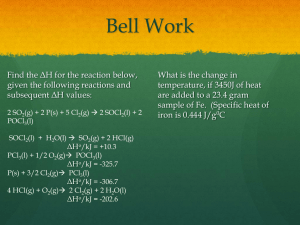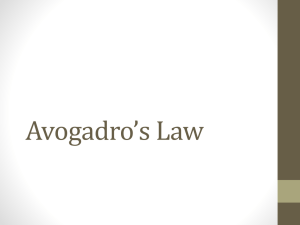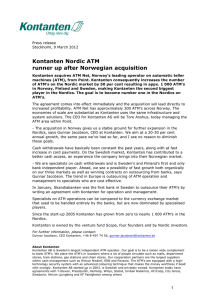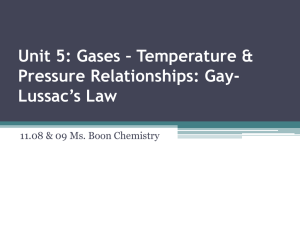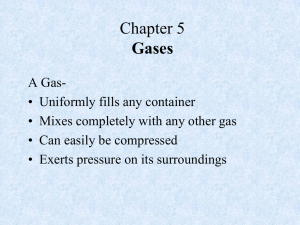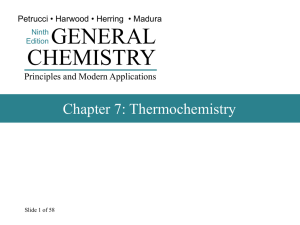P - Gainesville ISD
advertisement
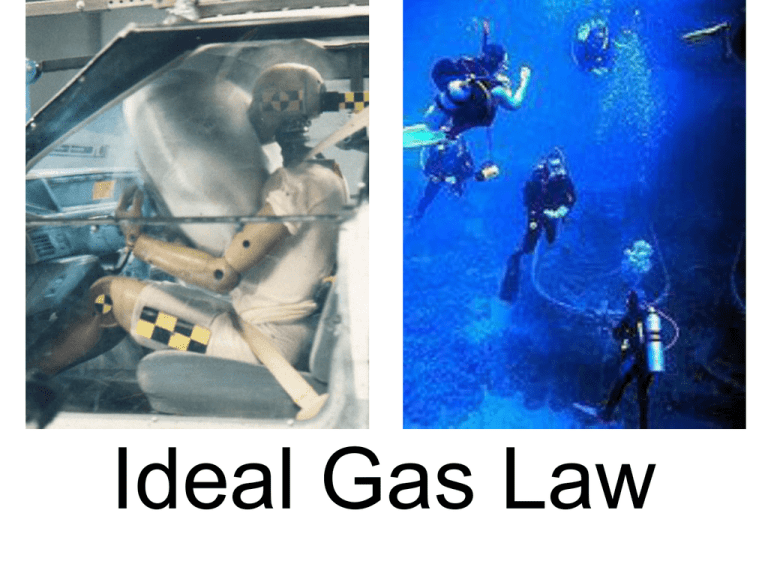
Ideal Gas Law Ideal Gas Equation This equation is a combination of 3 simpler gas relationships: Boyle’s law: V a 1 (at constant n and T) P Charles’ law: V a T (at constant n and P) Avogadro’s law: V a n (at constant P and T) Va nT P nT nT V = constant x =R P P R is the gas constant PV = nRT What does R=? The conditions 0 0C and 1 atm are called standard temperature and pressure (STP). Experiments show that at STP, 1 mole of an ideal gas occupies 22.414 L. PV = nRT (1 atm)(22.414L) PV R= = nT (1 mol)(273.15 K) L atm R = 0.082057 mol K Ideal Gas Problem #1 What is the volume (in liters) occupied by 49.8 g of HCl at a temperature of 25.0°C and a pressure of 0.950 atm? T = 25.0 + 273.15 = 298.15 K PV = nRT nRT V= P P = 0.950 atm n = 49.8 g x 1.37 mol x 0.0821 V= V = 35.3 L L•atm mol•K 1 mol HCl = 1.37 mol 36.45 g HCl x 298.15 K 0.950 atm At STP this same mass of HCl occupied a volume of 30.6 L Ideal Gas Problem #2 What is the volume (in liters) occupied by 49.8 g of HCl at STP? T = 0 0C = 273.15 K PV = nRT nRT V= P P = 1 atm n = 49.8 g x 1.37 mol x 0.0821 V= V = 30.6 L L•atm mol•K 1 mol HCl = 1.37 mol 36.45 g HCl x 273.15 K 1 atm In the last question, this same mass of HCl at 25°C and 0.95 atm had a volume of 35.3 L Ideal Gas Problem #3 What is the pressure (in atmospheres) of a gas in a 6.00 L container filled with 25.0 g of carbon dioxide at 23.5°C? T = 23.5°C+273.15 = 296.65 K PV = nRT nRT P= V P= V = 6.00 L 1 mol CO2 n = 25.0 g x = 0.568 mol 44.01 g CO2 L•atm 0.568 mol x 0.0821 mol•K x 296.65 K P = 2.31 atm 6.00 L Ideal Gas Problem #4 What is the temperature (in °C) of a gas in a 2.00 L container filled with 15.0 g of nitrogen with a pressure of 6.75 atm? P = 6.75 atm PV = nRT PV T= nR V = 2.00 L 1 mol N2 n = 15.0 g x = 0.535 mol 28.01 g N2 6.75 atm x 2.00 L T= L•atm 0.535 mol x 0.0821 mol•K T = 307.35 K – 273.15 = 34.2°C Ideal Gas Problem #5 What mass of oxygen gas occupies a volume of 1.50 L at 15.0 °C and 3.25 atm of pressure? T = 15.0°C+273.15 = 288.15 K PV = nRT V = 1.50 L P = 3.25 atm PV n= RT n= 3.25 atm x 1.50 L 0.0821 L•atm x 288.15 K mol•K n = 0.200 mol 32.00 g O2 = 6.41 g O 0.200 mol 2 1 mol O2 Ideal Gas Problem #6 (Making additional conversions) What mass of oxygen gas occupies a volume of 765 mL at 12.3 °C and 333 kPa of pressure? T = 12.3°C+273.15 = 285.45 K PV = nRT V = 765 mL P = 333 kPa PV n= RT n= 1 L 1000 mL 1 atm 101.3 kPa = 0.765 L = 3.29 atm 3.29 atm x 0.765 L 0.0821 L•atm x 285.45 K mol•K n = 0.107 mol 32.00 g O2 = 3.44 g O 0.107 mol 2 1 mol O2 Ideal Gas Problem #7 (Making additional conversions) What mass of radioactive radon gas occupies a volume of 439 mL at 101.9 °C and 950 mmHg of pressure? T = 101.9°C+273.15 = 375.05 K 1L -4 L V = 439 mL = 4.39x10 1106 m L PV = nRT P = 950 mmHg PV n= RT n= 1.25 atm x 4.39x10-4 L 0.0821 L•atm x 375.05 K 1 atm 760 mmHg = 1.25 atm n = 1.782x10-5 mol mol•K 1.782x10-5 222 g Rn mol 1 mol Rn = 4.00x10-3 g Rn Before & After Calculations In some situations, we know the amounts of all 4 variables and our task is to determine one of them under new conditions where one or more of the others are changing. Here is how we use PV=nRT for this situation: = constant Since PV nT We can use it to represent a “before” and “after” set of conditions like this: P1 V1 P V = 2 2 n1 T1 n2 T2 1 = before or initial and 2 = after or final Ideal Gas Problem #8 (Before & After) Argon is an inert gas used in lightbulbs to retard the vaporization of the filament. A certain lightbulb containing argon at 1.20 atm and 18°C is heated to 85°C at constant volume. What is the final pressure of argon in the lightbulb (in atm)? P1 V1 P2 V2 = n1 T1 n2 T2 Therefore: n, and V are constant so they can be left out of the equation. P1 P2 = T1 T2 P1 = 1.20 atm T1 = 291 K P2 = ? T2 = 358 K T2 = 1.20 atm x 358 K = 1.48 atm P2 = P1 x 291 K T1 Dalton’s Law of Partial Pressures Mixtures of gases require special handling when doing calculations. Collected gas Evaporated water Ptotal = P + P Collected gas Evaporated water Bottle being filled with oxygen gas NaClO3 Bottle full of oxygen gas and water vapor 2 NaClO3 (s) 2 NaCl (s) PT = PO + PH 2 + 3 O2 (g) 2 O Dalton’s Law of Partial Pressures V and T are constant P1 P2 Ptotal = P1 + P2 Pressure of Collected Gas Alone Pcollected gas = Ptotal - PH2O Total pressure of gas in container Vapor pressure of water at this temperature Consider a case in which two gases, A and B, are in a container of volume V. nART PA = V nA is the number of moles of A nBRT PB = V nB is the number of moles of B PT = PA + PB c c PB = PA = A PT Pi = cP i T nA A= nA + nB c c nB B = nA + nB B PT mole fraction ( c ) = nn i i T Gas Problem #9 A sample of natural gas contains 8.24 moles of CH4, 0.421 moles of C2H6, and 0.116 moles of C3H8. If the total pressure of the gases is 1.37 atm, what is the partial pressure of propane (C3H8)? Pi = c cP i propane T = PT = 1.37 atm 0.116 C H = 0.0132 + 0.421C H + 0.116C H 3 8.24CH 4 2 8 6 3 8 Ppropane = 0.0132 x 1.37 atm = 0.0181 atm Chemistry in Action: Scuba Diving and the Gas Laws P Depth (ft) Pressure (atm) 0 1 33 2 66 3 V


